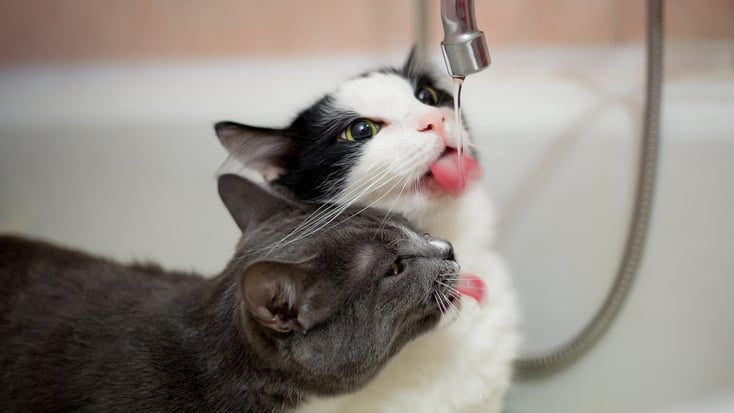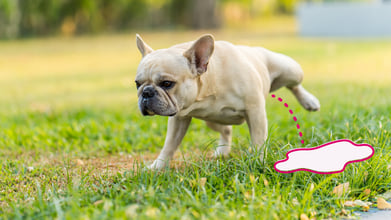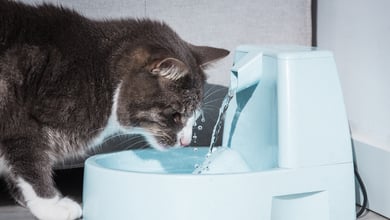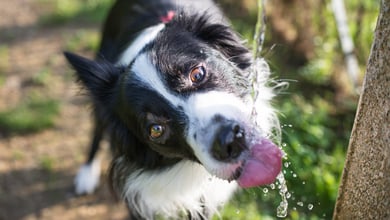Excessive Thirst in Cats: Causes & Treatment

Table of Contents
Does it concern you that your cat is drinking a lot more water than usual? You may ask "Why is my cat so thirsty?" This guide offers you insight into what could be the cause for unusual water intake by your pet and possible prevention and treatment methods.
Key Takeaways:
- Excessive thirst in cats, known as polydipsia, can be a sign of an underlying health problem and should be monitored closely.
- Common causes of increased thirst in cats include diabetes, liver disease, kidney disease, hyperthyroidism, urinary tract issues, and certain medications.
- Veterinary care and diagnostics are essential to determine the underlying cause and appropriate treatment for excessive thirst in cats.
What Is Excessive Thirst in Cats?
Excessive drinking in cats or increased thirst in cats is a condition known as polydipsia. It is evident by the increased water intake, which could lead to excessive urination (polyuria).
Polydipsia in cats can be due to different body system issues such as the reproductive, renal (kidney), hepatic (liver), and adrenal systems.
Other symptoms that can be accompanied by increased water consumption could be weight loss, reduced or changes in appetite, frequent urination, and lethargy.
Keep reading: 11 Signs Your Pet Needs to See a Vet
How Much Water Should a Cat Drink?
The ideal water intake of cats should be around 3.5 to 4.5 ounces of water for every 5 pounds they weigh daily.
However, your cat's water intake might be different from that of others, depending on other factors such as diet and climate. If your cat eats dry food, then it will be more prone to regular trips to the water bowl. Wet food has a higher water content, which reduces the need to drink as often.
Monitoring water intake will help pet parents determine if there is excessive water consumption. You can achieve this by filling your pet's water level to a dedicated mark on the bowl and leaving it for 24 hours. Take note of the water level changes at the end of each day for several days. This will help to determine what is normal for your pet's drinking behavior.
Common Causes of Increased Thirst in Cats
Polydipsia is normally a cause of concern and can indicate an underlying health problem. Here are possible causes of increased thirst in cats.
- Diabetes: Diabetes Mellitus (DM) can manifest as increased thirst.
- Liver disease: Excessive thirst can be a sign of liver disease in some cats.
- Kidney disease: Cats suffering from diseases like chronic kidney disease are likely to experience elevated thirst levels since their kidneys cannot filter unnecessary toxins from their bloodstream as well as hold on to the body's hydration. Thus, the cat consumes a lot of water.
- Hyperthyroidism: When the thyroid gland generates excess thyroid hormone, it leads to hyperthyroidism in cats. The overactivity of the glands often leads to increased thirst, increased appetite, weight loss, and restlessness.
- Urinary tract issues: Infections in the urinary tract and bladder stones can contribute to increased thirst and urination in your cat.
- Medications: Some medicines, like steroids or diuretics, can increase thirst.
1. Has your dog experienced rapid weight loss?
2. Has your dog’s appetite increased or decreased?
3. Is your dog more thirsty than usual?
4. Is your dog urinating more frequently than usual?
5. Is your dog less active than usual?
6. Does your dog have cloudy eyes or is experiencing vision problems?
7. Is your dog experiencing frequent urinary tract infections?
8. Does your dog have sweet-smelling breath?
9. Does your dog seem more lethargic than usual?
10. Does your dog have a family history of diabetes?
11. Is your dog's coat dull or thinning?
12. Has your dog had frequent skin infections?
1. Is your cat urinating more frequently than usual?
2. Is your cat more thirsty than usual?
3. Has your cat experienced rapid weight loss?
4. Is your cat showing signs of muscle weakness?
5. Has your cat’s appetite increased or decreased?
6. Does your cat seem more lethargic than usual?
7. Is your cat vomiting more than usual?
View Results
There are a handful of other underlying medical conditions related to excessive thirst such as electrolyte abnormalities, cancer, infections, and some other less common endocrine disorders.
When to Seek Veterinary Care
If you notice the following with your cat, you need to seek veterinary care:
- Your cat drinks more than 5 ounces (per 5 pounds of body weight) in a day.
- Increased thirst is paired with increased urination.
- Excessive thirst is associated with diarrhea or vomiting.
- There is a change in appetite and weight.
Veterinary Diagnosis of Felines with Excessive Thirst
Since the symptoms that your pet experiences might be from a more serious underlying condition, the veterinarian’s medical attention is crucial. Your veterinarian will perform the diagnosis process by carrying out a full physical exam and performing diagnostics. A clear medical history will be obtained from you to provide a broader picture of your cat’s health.
The veterinarian will require information such as:
- Your pet's general health conditions
- Changes in weight and appetite as well as changes in behavior
- Abnormal urine appearance, odor, urinating in unusual places, and frequency
- Recent medicine administration
The physical examination and diagnostics may include the following:
- Urinalysis and Urine culture, complete blood work, water intake measurement, blood pressure, and diagnostic imaging
- Checking vaginal discharge or expanded uterus in case of pyometra in unfixed females
- Palpating the stomach to verify the size of the liver and kidneys
- Hydration status
- Demeanor observation
Treatment Options for Increased Thirst in Cats
Treatment for excessive thirst depends on the underlying cause once the diagnosis has been made. Some of the options include the following:
- Kidney disease/failure: treatment includes dietary modification, maintaining hydration, and treating possible complications such as urinary tract infections and hypertension.
- Electrolyte abnormalities: treatment is based on the underlying change and could include electrolyte supplementation and/or fluid therapy
- Diabetes mellitus: treatment depends on the severity and can involve the administration of insulin, electrolyte therapy, and in severe cases intensive fluid therapy.
- Hyperthyroidism: treatment with daily prescription therapy or radioactive iodine
Prevention for Cats with Excessive Thirst
Tips to prevent your cat from experiencing excessive thirst include the following:
- Regular complete pet wellness checks
- Promoting a balanced and appropriate diet
- Encouraging regular exercise and mental stimulation
- Maintaining a clean and fresh water source
Conclusion
Excessive water intake by your cats can be due to an underlying health condition. Observe and measure how much your cat drinks and its body language. If you have any concerns, consult a veterinarian.
Frequently Asked Questions
Why is my cat drinking a lot of water and peeing a lot?
Polyuria and polydipsia refer to excessive urination and water intake. Your cat might be suffering from diabetes, renal issues, hepatic problems, or reproductive disorders.
Why is my cat with an excessive thirst not eating?
It could be due to an underlying issue; therefore, visit your veterinarian for a consultation.
Why is my senior cat drinking a lot of water?
Excessive water drinking can be simply due to a habit, or it may be an indication of underlying health issues in your pet. Seek help from your veterinarian.
Should I be worried if my cat is drinking more water than usual?
Naturally, most cats do not drink much water, although it depends on their diet. If you notice your cat drinking a lot more than normal, then you should consult your veterinarian.






